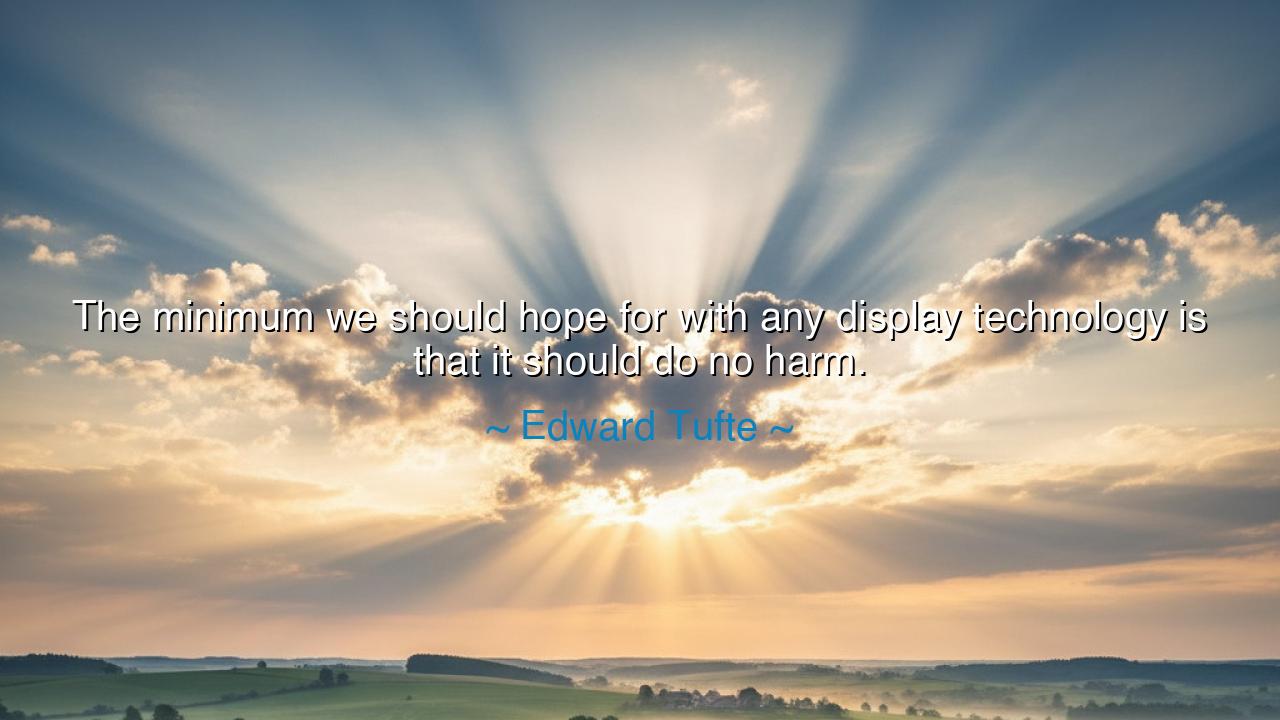
The minimum we should hope for with any display technology is
The minimum we should hope for with any display technology is that it should do no harm.






The words of Edward Tufte, “The minimum we should hope for with any display technology is that it should do no harm,” are a call to humility and responsibility in the age of information. Tufte, a master of data visualization and the great critic of cluttered, misleading charts, reminds us that technology is not neutral when it presents knowledge. A display can illuminate truth, but it can also obscure, deceive, and even endanger lives. Thus, the first commandment of every maker, every communicator, every designer must be simple: cause no harm in the telling of truth.
The origin of this quote is rooted in Tufte’s lifelong critique of how data and information are presented. He has long warned against “chartjunk”—useless decoration and misleading scales that distort meaning. In his writings, he often pointed to disasters caused by bad displays of information, the most infamous being the Space Shuttle Challenger explosion. Before the tragedy, engineers had presented warnings about O-ring failures in poorly designed charts, cluttered and unclear. The display technology did not clarify the truth; it concealed it. The result was catastrophe. From such failures, Tufte drew the moral law: the very least we must demand is that technology, in its duty to show, should not harm.
This teaching finds echoes in history. Consider the medieval scribes who copied sacred manuscripts. They knew that a single misplaced stroke could alter meaning, and thus they labored with reverence, ensuring that the words passed on would do no harm to faith or law. Or recall the physicians of antiquity, who swore the Hippocratic oath: first, do no harm. Tufte extends this ancient wisdom into the modern domain of data and imagery, where the physician’s scalpel has become the designer’s chart, and the battlefield of health has become the battlefield of truth.
The deeper meaning is that clarity is a moral duty. When one presents numbers, charts, or images, one is not merely creating decoration; one is guiding decisions, shaping thought, and influencing action. A confused chart can waste time, but a deceptive one can destroy trust, wealth, even life. Thus, Tufte’s law is not trivial—it is a shield of ethics in an age when the flood of information threatens to drown discernment. The maker of displays wields great power, and power demands responsibility.
Yet there is also hope in his words. For if the minimum duty is to do no harm, then the greater calling is to do good: to enlighten, to clarify, to empower. A well-crafted chart or display can pierce through confusion like sunlight through fog, enabling leaders to act wisely, citizens to make informed choices, and students to see patterns that awaken understanding. The display becomes not just neutral, but transformative—a tool for justice, progress, and truth.
For those who live in this time, the lesson is urgent. In your own work—whether in writing, teaching, designing, or speaking—ask first: Does this clarify, or does it confuse? Does this serve truth, or does it serve vanity? Be wary of needless decoration, of manipulations that bend the truth for comfort or spectacle. The world does not need more noise; it needs clarity. Your duty is not to impress, but to illuminate.
So let us pass this teaching to the generations: the first law of display is the same as the first law of healing—do no harm. From this foundation, build works that serve truth. Let your displays be windows, not walls; lanterns, not shadows. For in the clarity of honest design lies the path to wisdom, and in wisdom, the preservation of life and the flourishing of all people.






AAdministratorAdministrator
Welcome, honored guests. Please leave a comment, we will respond soon